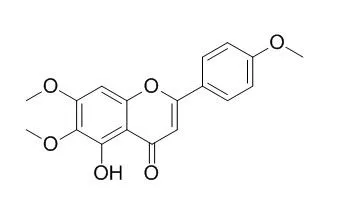| Description: |
Salvigenin, a potent hMAO-A [monoamine oxidases (MAOs)]inhibitor,
has neuroprotective, antitumor and immunomodulatory effects, it has potential to ameliorate Streptozotocin-induced diabetes mellitus and heart complications in rats. Salvigenin has dose-dependent analgesic effect so that it can be useful in controlling of inflammations, acute and chronic pain. |
| In vitro: |
| Mol Cell Biochem. 2012 Dec;371(1-2):9-22. | | Increase of autophagy and attenuation of apoptosis by Salvigenin promote survival of SH-SY5Y cells following treatment with H₂O₂.[Pubmed: 22899171] | Oxidative stress is a major component of harmful cascades activated in neurodegenerative disorders.
METHODS AND RESULTS:
Here, we tried to elucidate the possible neuroprotective effect of Salvigenin, a natural polyphenolic compound, on oxidative stress-induced apoptosis and autophagy in human neuroblastoma SH-SY5Y cells. We measured cell viability by MTT test and found that 25 μM is the best protective concentration of Salvigenin. GSH and SOD assays suggested that Salvigenin activates antioxidant factors. At the same time, measurement of ER stress-associated proteins including calpain and caspase-12 showed the ability of Salvigenin to decrease ER stress. We found that Salvigenin could decrease the apoptotic factors. Salvigenin inhibited H(2)O(2)-induced caspase-3 which is a hallmark of apoptosis in addition to reducing Bax\Bcl-2 ratio by 1.45 fold. Additionally, Salvigenin increased the levels of autophagic factors.
CONCLUSIONS:
Our results showed an increase in LC3-II/LC3-I ratio, Atg7, and Atg12 in the presence of 25 μM of Salvigenin by about 1.28, 1.25, and 1.54 folds, respectively, compared to H(2)O(2)-treated cells. So it seems that H(2)O(2) cytotoxicity mainly results from apoptosis. Besides, Salvigenin helps cells to survive by inhibiting apoptosis and enhancing autophagy that opens a new horizon for the future experiments. |
|
| In vivo: |
| Cell Immunol. 2013 Nov-Dec;286(1-2):16-21. | | Antitumor and immunomodulatory effects of salvigenin on tumor bearing mice.[Pubmed: 24270218] | Development of agents that specifically kill cancer cells and simultaneously elicit antitumor immune response is a step forward in cancer therapy. Immunostimulation can result in eliminating of the cancer cells; immunotherapy is a promising approach in balancing the immune response by Treg.
METHODS AND RESULTS:
In the present study, we investigated whether the administration of Salvigenin contributes to the augmentation of antitumor immunity and the regression of tumor tissues in a mouse model of breast cancer. Salvigenin was purified from Tanacetum canescens, and its effect on the tumor volume was investigated. The splenocyte proliferation, shifting of cytokine profile, and the presence of naturally-occurring CD4+CD25+Foxp3+ Treg cells were assessed to describe the anti-tumor immune response.
CONCLUSIONS:
Our results demonstrated that a significant decrease in the level of IL-4 and increase in the IFN-γ in the animals treated with Salvigenin and significant decreased in the level of splenic CD4+CD25+Foxp3+ T regulatory cells. The cytotoxic and immunomodulatory properties of Salvigenin were acknowledged in vivo. | | Advaced Herbal Medicine , 2015, 1(3):31-41. | | Anti-inflammatory and Analgesic Properties of Salvigenin, Salvia officinalis Flavonoid Extracted.[Reference: WebLink] | Salvigenin is one of the active flavonoids existing in this plant. The aim of this study was to evaluate the anti-inflammatory and analgesic effect of Salvigenin, Salvia officinalis flavonoid extracted.
METHODS AND RESULTS:
In this laboratory experimental study, plant was extracted and the column chromatography was used to purify prepared extracts. 100 male albino mice and 48 male wistar rats were selected. In the hot plate test and in the writhing test, animals were divided randomly into 5 groups. Group 1 (received 10 mg/kg normal saline), groups 2, 3 and 4 (received Salvigenin 25, 50 and 100 mg/kg intraperitoneally, espectively), group 5 (received 10 mg/kg morphine in hot plate test and 10 mg/kg indomethacin in writhing test). In the inflammatory test, animals were divided into 6 groups. Group 1 was assigned as a control group which received 0.05 ml of carrageenin. Groups 2, 3 and 4 (received Salvigenin, at doses of 25, 50 and 100 mg/kg). Group 5 (received 10 mg/kg indomethacin) and then changes of the volume of all groups were measured. Data were analyzed using ANOVA and Tukey test and P. In writhing test, Salvigenin reduced the number of abdominal contractions at doses of 50 and 100 mg/kg. Increasing dose of Salvigenin, with reduction in abdominal cramps resulted in the increasing of pain inhibition, and the percentage of this inhibition was statistically significant (P<0.001). In hot plate test, also 30, 45 and 60 minutes after injection of Salvigenin and morphine showed significant difference compared to the control group (P<0.001). Also, Salvigenin increased the maximum percentage of analgesic compared to the control group (P<0.001). Salvigenin could reduce inflammation and in the group that received Salvigenin at 100 mg/kg, the inflammation was significantly lower than the control group (P<0.05).
CONCLUSIONS:
Our findings showed that Salvigenin has dose-dependent analgesic effect so that it can be useful in controlling of inflammations, acute and chronic pain. |
|






 Cell. 2018 Jan 11;172(1-2):249-261.e12. doi: 10.1016/j.cell.2017.12.019.IF=36.216(2019)
Cell. 2018 Jan 11;172(1-2):249-261.e12. doi: 10.1016/j.cell.2017.12.019.IF=36.216(2019) Cell Metab. 2020 Mar 3;31(3):534-548.e5. doi: 10.1016/j.cmet.2020.01.002.IF=22.415(2019)
Cell Metab. 2020 Mar 3;31(3):534-548.e5. doi: 10.1016/j.cmet.2020.01.002.IF=22.415(2019) Mol Cell. 2017 Nov 16;68(4):673-685.e6. doi: 10.1016/j.molcel.2017.10.022.IF=14.548(2019)
Mol Cell. 2017 Nov 16;68(4):673-685.e6. doi: 10.1016/j.molcel.2017.10.022.IF=14.548(2019)